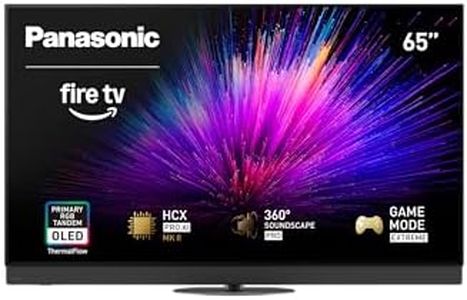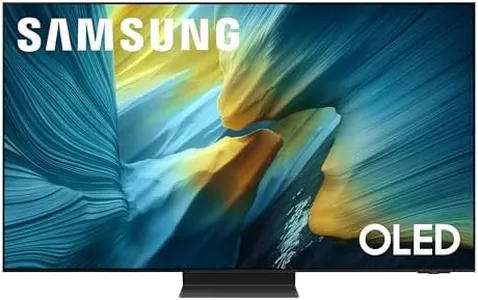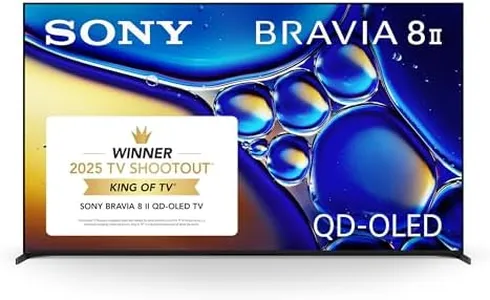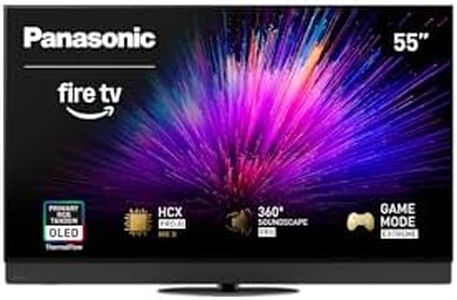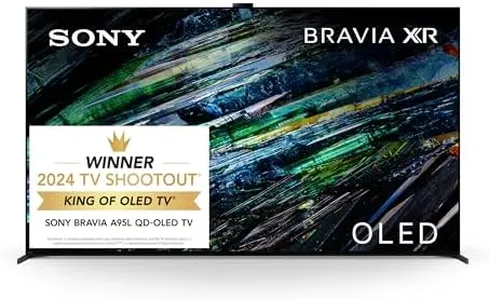10 Best Oled Tvs 2025 in the United States
Our technology thoroughly searches through the online shopping world, reviewing hundreds of sites. We then process and analyze this information, updating in real-time to bring you the latest top-rated products. This way, you always get the best and most current options available.

Our Top Picks
Winner
Panasonic Z85 Series (2024 Model) 65-inch OLED 4K Ultra HD Smart Fire TV, Dolby Vision IQ, HDR10+ Adaptive, 120Hz Refresh Rate - 65Z85AP
Most important from
173 reviews
The Panasonic Z85 Series 65-inch OLED TV is designed to deliver an impressive viewing experience, especially for those who appreciate stunning visuals and top-notch audio. With a 4K Ultra HD resolution of 3840 x 2160 and support for multiple HDR formats like Dolby Vision and HDR10+, the TV excels in producing vibrant colors and excellent contrast, making it great for watching movies and shows in various lighting conditions. Its HCX Pro AI Processor MKII enhances picture quality further, ensuring that the image is clear and detailed.
One of the standout features is its 120Hz refresh rate, which is ideal for fast-paced content, such as sports and action movies. Gamers will particularly appreciate the Game Mode Extreme, which supports HDMI 2.1 and features like VRR and AMD FreeSync Premium, making it a good choice for those looking for a smooth gaming experience.
Audio-wise, the Theater Surround Pro with Dolby Atmos offers an engaging sound experience, with clear dialogue and rich bass due to the built-in subwoofer, effectively immersing viewers in the action on-screen. The TV is packed with advanced features, which might be overwhelming for users who prefer simplicity. The inclusion of Fire TV may be a drawback for those who favor other streaming platforms or interfaces. Additionally, it is relatively heavy at nearly 61 pounds, which could pose a challenge during setup.
The Panasonic Z85 Series OLED TV is an excellent choice for movie lovers and gamers alike, thanks to its stunning picture quality and immersive sound. However, potential buyers should consider their familiarity with smart TV features and weight when making their decision.
Most important from
173 reviews
Panasonic Z85 Series (2024 Model) 55-inch OLED 4K Ultra HD Smart Fire TV, Dolby Vision IQ, HDR10+ Adaptive, 120Hz Refresh Rate - 55Z85AP
Most important from
173 reviews
The Panasonic Z85 Series 55-inch OLED TV is a strong choice for those looking for a high-quality 4K OLED TV with excellent picture performance. Its 55-inch screen size is ideal for medium to large rooms, delivering sharp 4K Ultra HD resolution with deep blacks and vibrant colors thanks to the OLED panel. It supports multiple HDR formats including HDR10, HDR10+, Dolby Vision IQ, and HLG, which means it adapts the picture based on your room's lighting for a more natural viewing experience.
The 120Hz refresh rate and support for gaming features like HDMI 2.1, VRR, FreeSync Premium, and NVIDIA G-SYNC make it well-suited for gamers seeking smooth and responsive gameplay. On the audio side, the Theater Surround Pro with Dolby Atmos and a built-in subwoofer provide immersive sound with clear dialogue and rich bass, enhancing movies and shows. Connectivity options like Bluetooth add convenience for connecting external devices. The smart TV experience is powered by Fire TV, offering a wide range of apps and voice control, making it user-friendly for streaming and smart home integration.
Weighing around 42 pounds, it’s a solidly built TV but not overly bulky. This model balances excellent OLED picture quality with advanced gaming and smart features, making it a versatile choice for movie lovers, gamers, and everyday streaming users.
Most important from
173 reviews
Panasonic Z95 Series (2024 Model) 65-inch OLED 4K Ultra HD Smart Fire TV, Dolby Vision IQ, HDR10+ Adaptive, 144Hz Refresh Rate and Hands-Free Alexa - 65Z95AP
Most important from
50 reviews
The Panasonic Z95 Series 65-inch OLED TV is a premium choice for anyone looking to elevate their home entertainment experience. With its 4K Ultra HD resolution and advanced OLED technology, you'll enjoy stunning color accuracy and brightness, making movies and shows come to life. The TV supports multiple HDR formats, including Dolby Vision and HDR10+, which means you’ll see optimized picture quality that adjusts based on your room's lighting, enhancing your viewing experience.
For gamers, this model stands out with a 144Hz refresh rate and support for HDMI 2.1 features like VRR and FreeSync, ensuring smooth gameplay. The Game Mode Extreme is tailored for enthusiasts who want the best performance during those intense gaming sessions. Plus, the Game Control Board adds convenience by allowing you to quickly check your gaming settings.
Audio is another highlight, with the 360 Soundscape Pro technology from Technics. The combination of upward and side-firing speakers with Dolby Atmos creates an immersive sound environment, effectively pulling you into the action, which is particularly beneficial for movie lovers and gamers alike. On the smart functionality side, the built-in Fire TV offers easy access to a wide range of content, along with voice control capabilities via Alexa. This makes it user-friendly and enhances the viewing experience by providing personalized content recommendations.
Most important from
50 reviews
Buying Guide for the Best Oled Tvs
Shopping for an OLED TV can be exciting, as these televisions are known for their stunning picture quality and vibrant colors. However, to pick the best model for your needs, it’s important to understand the core features that influence your viewing experience. A thoughtful approach will help you zero in on an OLED TV that matches your room, viewing habits, and expectations for smart features and connectivity.FAQ
Most Popular Categories Right Now




